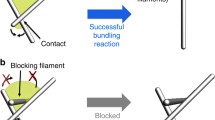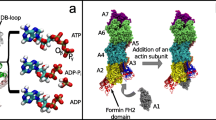Abstract
Gels formed from G-actin or other filament-forming monomers exhibit a range of morphologies that differ widely in terms of pore size, fiber diameter, degree of isotropy, and frequency of cross-linking or branching. These characteristics are determined, in large part, by the nature and concentration of the proteins that form cross-links between single filaments, yet little is known how filament-forming monomers and cross-linkers assemble to generate a particular network morphology. Some of the important attributes of a cross-linker are the spatial and angular orientation of its two filament binding sites, its size, and stiffness to both rotation and extension. Here, we introduce a Brownian dynamics (BD) simulation model in three dimensions in which actin monomers polymerize and become cross-linked by two types of cross-linking molecules that form either parallel filament bundles or perpendicular cross-links. We analyze the effects of various system parameters on the growth and morphology of the resulting network. Some scaling behaviors emerge that are insensitive to the detailed choice of parameters. Our model thus has the potential as a base BD model that can be further refined for investigating various actin-related phenomena.











Similar content being viewed by others
References
Howard J (2001) Mechanics of motor proteins and the cytoskeleton. Sinauer Associates, Sunderland, MA.
Lodish H, et al (2003) Molecular cell biology, 5th edn. W. H. Freeman and Company, New York, NY.
Sept D, McCammon JA (2001) Thermodynamics and kinetics of actin filament nucleation. Biophys J 81(2):667–674.
Cooper JA, et al (1983) Kinetic evidence for a monomer activation step in actin polymerization. Biochemistry 22(9):2193–2202.
Mofrad MRK, Kamm RD (2006) Cytoskeletal mechanics: Models and measurements. Cambridge University Press, New York, NY.
Kreis T, Vale R (1999) Guidebook to the cytoskeletal and motor proteins, 2nd edn. Oxford University Press, New York, NY.
Le Y, Sept D, Carlsson AE (2006) Energetics and dynamics of constrained actin filament bundling. Biophys J 90(12):4295–4304.
Chu JW, Voth GA (2005) Allostery of actin filaments: Molecular dynamics simulations and coarse-grained analysis. P Natl Acad Sci USA 102(37):13111–13116.
Chu JW, Voth GA (2006) Coarse-grained modeling of the actin filament derived from atomistic-scale simulations. Biophys J 90(5):1572–1582.
Sept D, Elcock AH, McCammon JA (1999) Computer simulations of actin polymerization can explain the barbed-pointed end asymmetry. J Mol Biol 294(5):1181–1189.
Carlsson AE (2006) Stimulation of actin polymerization by filament severing. Biophys J 90(2):413–422.
Yu XP, Carlsson AE (2003) Multiscale study of counterion-induced attraction and bundle formation of F-actin using an ising-like mean-field model. Biophys J 85(6):3532–3543.
Yu XP, Carlsson AE (2004) Kinetics of filament bundling with attractive interactions. Biophys J 87(6):3679–3689.
Atilgan E, Wirtz D, Sun SX (2006) Mechanics and dynamics of actin-driven thin membrane protrusions. Biophys J 90(1):65–76.
Gov NS, Gopinathan A (2006) Dynamics of membranes driven by actin polymerization. Biophys J 90(2):454–469.
Shlomovitz R, Gov NS (2007) Membrane waves driven by actin and myosin. Phys Rev Lett 98(16):168103-1–168103-4.
Reif F (1965) Fundamentals of statistical and thermal physics. McGraw-Hill, New York, NY.
Underhill PT, Doyle PS (2004) On the coarse-graining of polymers into bead-spring chains. J Non-Newton Fluid Mech 122(1–3):3–31.
Liao Q, Dobrynin AV, Rubinstein M (2003) Molecular dynamics simulations of polyelectrolyte solutions: Nonuniform stretching of chains and scaling behavior. Macromolecules 36(9):3386–3398.
Kojima H, Ishijima A, Yanagida T (1994) Direct measurement of stiffness of single actin-filaments with and without tropomyosin by in-vitro nanomanipulation. P Natl Acad Sci USA 91(26):12962–12966.
Higuchi H, Yanagida T, Goldman YE (1995) Compliance of thin-filaments in skinned fibers of rabbit skeletal-muscle. Biophys J 69(3):1000–1010.
Isambert H et al (1995) Flexibility of actin-filaments derived from thermal fluctuations-effect of bound nucleotide, phalloidin, and muscle regulatory proteins. J Biol Chem 270(19):11437–11444.
Gittes F et al (1993) Flexural rigidity of microtubules and actin-filaments measured from thermal fluctuations in shape. J Cell Biol 120(4):923–934.
Tsuda Y et al (1996) Torsional rigidity of single actin filaments and actin-actin bond breaking force under torsion measured directly by in vitro micromanipulation. P Natl Acad Sci USA 93(23):12937–12942.
Yasuda R, Miyata H, Kinosita K (1996) Direct measurement of the torsional rigidity of single actin filaments. J Mol Biol 263(2):227–236.
Holmes KC et al (1990) Atomic model of the actin filament. Nature 347(6288):44–49.
Pollard TD (1986) Rate constants for the reactions of Atp–actin and Adp–actin with the ends of actin-filaments. J Cell Biol 103(6):2747–2754.
Bell GI (1978) Models for specific adhesion of cells to cells. Science 200(4342):618–627.
Damköhler G (1939) Stromungs und warmeubergangsprobleme in chemischer technik and forschung. Chem Ing Tech 12:469.
Forgacs G (1995) On the possible role of cytoskeletal filamentous networks in intracellular signaling—an approach based on percolation. J Cell Sci 108:2131–2143.
Nakayama T, Yakubo K, Orbach RL (1994) Dynamical properties of fractal networks-scaling, numerical simulations, and physical realizations. Rev Mod Phys 66(2):381–443.
Head DA, Levine AJ, MacKintosh EC (2003) Deformation of cross-linked semiflexible polymer networks. Phys Rev Lett 91(10): 108102-1–108102-4.
Head DA, Levine AJ, MacKintosh FC (2003) Distinct regimes of elastic response and deformation modes of cross-linked cytoskeletal and semiflexible polymer networks. Phys Rev E 68(6): 061907-1–061907-15.
Volkmann N, et al (2001) An atomic model of actin filaments cross-linked by fimbrin and its implications for bundle assembly and function. J Cell Biol 153(5):947–956.
Wagner B, et al (2006) Cytoskeletal polymer networks: The molecular structure of cross-linkers determines macroscopic properties. P Natl Acad Sci USA 103(38):13974–13978.
Claessens MMAE, et al (2006) Actin-binding proteins sensitively mediate F-actin bundle stiffness. Nat Mater 5(9):748–753.
Dalhaimer P, Discher DE, Lubensky TC (2007) Crosslinked actin networks show liquid crystal elastomer behaviour, including soft-mode elasticity. Nat Phys 3(5):354–360.
Tseng Y, et al (2004) The bimodal role of filamin in controlling the architecture and mechanics of F-actin networks. J Biol Chem 279(3):1819–1826.
Costa KD, Hucker WJ, Yin FCP (2002) Buckling of actin stress fibers: A new wrinkle in the cytoskeletal tapestry. Cell Motil Cytoskel 52(4):266–274.
Pender N, Mcculloch CAG (1991) Quantitation of actin polymerization in 2 human fibroblast subtypes responding to mechanical stretching. J Cell Sci 100:187–193.
Yap B, Kamm RD (2005) Mechanical deformation of neutrophils into narrow channels induces pseudopod projection and changes in biomechanical properties. J Appl Physiol 98(5):1930–1939.
Trepat X, et al (2007) Universal physical responses to stretch in the living cell. Nature 447(7144):592–595.
Dhont JKG, Briels WJ (2003) Inhomogeneous suspensions of rigid rods in flow. J Chem Phys 118(3):1466–1478.
Belagyi J, Grof P (1983) Rotational motion of actin monomer at low and high salt concentration. Eur J Biochem 130(2):353–358.
Oda T, et al (1998) Effect of the length and effective diameter of F-actin on the filament orientation in liquid crystalline sols measured by X-ray fiber diffraction. Biophys J 75(6):2672–2681.
Isambert H, Maggs AC (1996) Dynamics and rheology of actin solutions. Macromolecules 29(3):1036–1040.
Humphrey W, Dalke A, Schulten K (1996) VMD: Visual molecular dynamics. J Mol Graph 14(1):33–38.
Acknowledgments
We gratefully acknowledge support of the NIH (GM076689) and a fellowship to TYK from the Samsung Scholarship Foundation.
Author information
Authors and Affiliations
Corresponding author
Rights and permissions
About this article
Cite this article
Kim, T., Hwang, W. & Kamm, R.D. Computational Analysis of a Cross-linked Actin-like Network. Exp Mech 49, 91–104 (2009). https://doi.org/10.1007/s11340-007-9091-3
Received:
Accepted:
Published:
Issue Date:
DOI: https://doi.org/10.1007/s11340-007-9091-3




